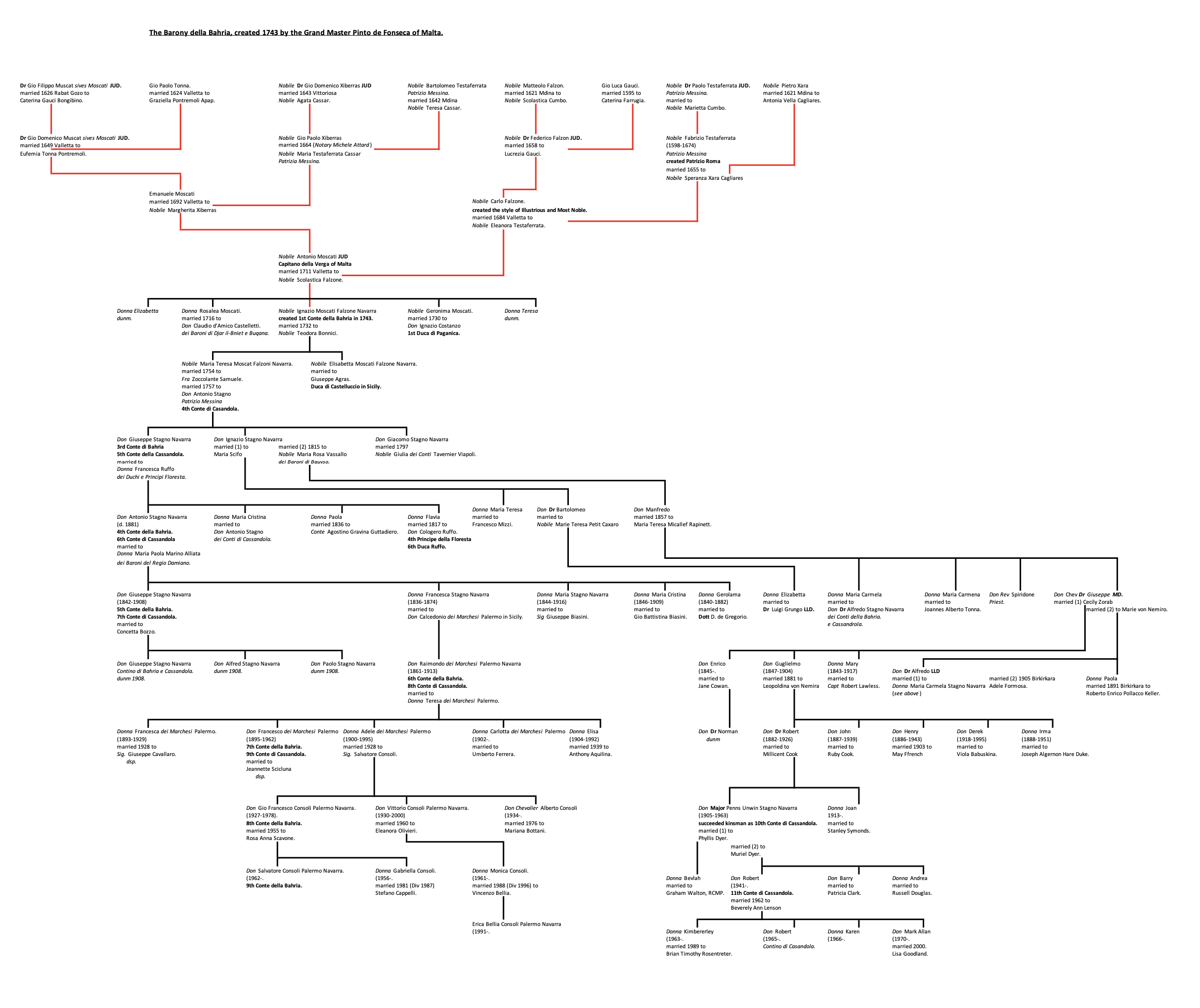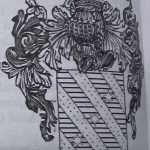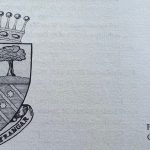Conte’s della Bahria.
Last Update: 16-04-2023.
Granted to: Nobile Ignazio Moscati Falzoni Navarra.
By: Manoel Pinto de Fonseca, Grand Master of Malta.
On: 1743 in Valletta.
British Crown recognition: 1878.
With Remainder to: The terms of the diploma differ from those of the other titles granted by the Grand Masters. In fact, the title of Conte della Bahria was annexed to the lands of the same name, situated in Malta, and which were erected by the said patent into a noble feud. Moreover, the title is inheritable not only by one of the grantee’s descendents, but by his sons and successors, whether relations or strangers, and it is annexed to the possession of those lands. The following is an extract from the diploma: Te Dnum Igantium Muscati Falsone Navarra tuosque filios, haeredes, et successores etiam extraneos, comitem et comites Territorii seu Tenutae della Bahria positae in hac Nostra Insula a Te et antecessoribus tuis jure pleni dominii et proprietatis possessae constitumus et in perpetuum creamus, dictamque tenutam seu territorum, illusque membra et districtum in feudum nobilem sub titulo comitis erigimus atque extollimus. Tuosque filios, haeredes, et successores etiam extraneos, comitem et comites Territorii seu Tenutae della Bahria positae in hac Nostra Insula a Te et antecessoribus tuis jure pleni dominii et proprietatis possessae constitumus et in perpetuum creamus, dictamque tenutam seu territorum, illusque membra et districtum in feudum nobilem sub titulo comitis erigimus atque extollimus.
List of Title holders:
1. Nobile Ignazio Moscati Falsoni Navarra, 1st Count, succeeded by his daughter.
2. Nobile Maria Teresa Moscati Falsoni Navarra Stagno, 2nd Contessa, (c. 1757), succeeded by her eldest son.
3. Don Giuseppe Stagno Navarra, 5th Conte di Casandola, 3rd Conte, succeeded by his eldest son.
4. Don Antonio Stagno Navarra, 6th Conte di Casandola, 4th Conte, (d. 1881), succeeded by his son.
5. Don Giuseppe Stagno Navarra, 7th Conte di Casandola, 5th Conte, (d. 1908), succeeded by his nephew.
6. Don Raimondo Palermo Navarra, 8th Conte di Casandola, 6th Conte, (d. 1913), succeeded by his son.
7. Don Francesco Paolo Palermo Navarra, 9th Conte di Casandola, 7th Conte, (d. 1962), succeeded by his nephew.
8. Don Gio Francesco Consoli Palermo Navarra, 8th Conte, (d. 1978), succeeded by his son.
9. Don Salvatore Consoli Palermo Navarra, 9th Conte, (1962-.
Heir: Donna Gabriella Consoli, (1956-.
Articles relating to this title:
Footnote: Unlike the great majority of titles conferred by the Grand Masters, the title of “Conte dellaBahria” was specifically conferred so as to further enhance a territory already held by the grantee. This title was granted by Grand Master Pinto on the 16 May 1743 to Don Ignazio Muscati Falsone Navarra.
In any case, it is to be especially remarked that this title “follows” the tenure of the territory known as “Bahria”. That is to say, unlike other titles which provide for a remainder in favour of descendants of the relative grantee, succession to this title is to be reckoned according to the possessor of the land. This effectively means that the title may be succeeded to by strangers in blood of Ignazio Muscati FalsoneNavarra. Moreover, the Report observes that the remainder of the above extract favours not only the one of the grantees descendants, but the grantee’s sons, heirs, AND successors (filios, haeredes, et successores etiamextraneos), meaning that grant may allow to a plurality of claims being founded on the grant dated 1742. This view appears to be reinforced by the grant’s use of the term comitem et comites.
This observation was made by the Royal Commissioners. (See:- “Correspondence and Report of the Commission appointed to enquire into the claims and grievances of the Maltese Nobility”, May 1878, presented to both Houses of Parliament by Command of Her Majesty (C.-2033.) (See Report Paras. 37-38).
The actual report says the following:
“The next title is that of ‘Conte della Bahria’, conferred by Grand Master Dr. D. Emmanuel Pinto de Foncesca by a diploma of the 16th May 1743. This is the first title of count which appears to have been granted by the Grand Masters, the former patents containing only grants of baronies. It was conferred upon Don Ignazio MuscatiFalsone Navarra. The terms of the diploma differ from those of the six preceding charters, which are worded in anuniform style, and which confer the power to each holder of the title to name his successor. The title of “Contedella Bahria” was annexed to the lands of the same name, situated in this island, and which were erected by the said patent into a noble feud. The title is inheritable not only by one of the grantee’s descendents, but by his sons and successors, whether relations or strangers, and it is annexed to the possession of those lands. The following isan extract from the diploma: Te Dnum Igantium Muscati Falsone Navarra tuosque filios, haeredes, et successoresetiam extraneos, comitem et comites Territorii seu Tenutae della Bahria positae in hac Nostra Insula a Te et antecessoribus tuis jure pleni dominii et proprietatis possessae constitumus et in perpetuum creamus, dictamquetenutam seu territorum, illusque membra et districtum in feudum nobilem sub titulo comitis erigimus atqueextollimus. The present holder of the lands of Bahria is Antonio Stagno Navarra Muscati, who resides at Messina. His pedigree through a female line is fully proved, and no one has appeared to dispute his right to the exclusive title of conte, which unquestionably belongs to him as the possessor of the feud to which it is annexed. He will be referred to in the list appended to this Report, as “Antonio Stagno Conte della Bahria”.”
From a reading of the above, the territory appears to have been elevated into noble fief. A closer examination of this grant reveals that the grant envisages a situation where the property can be held by a plurality of Muscati’s sons and successors. This consideration is more acute when one considers that unlike the title of Catena discussed elsewhere, the extract quoted above does not include the limitation successoresprimogenitos. The very wide terms of this grant in favour of males thus allows for many claims in favour of all males descending from Muscati. On the other hand, this consideration should be tempered by the consideration that fiefs were usually held as an indivisible property. Therefore although the grant envisages the possibility of a plurality of sons of the grantee, the remainder is effectively restricted only by reason of the indivisible nature of the fief.
Moreover, in view of the fact that the holding of properties in fief, was (a) subsequently revoked by the DISENTAILMENT OF PROPERTY (EXTENSION TO FIEFS) ACT (ACT XXX of 1969) and that (b) this ACT makes specific provision nothing therein “affects any title of nobility”, thereby ensuring a statutory exception to the automatic extinction of a nobiliary title in the event of an extinction of the fief to which the title refers, and (c) that once extinguished in 1969, the noble fief of Bahria was thereafter held like any other property, it follows that if this former fief were to be dismembered into smaller pieces, any (male) successor of a dismembered part of the territory of Bahria would be entitled to the title! This latter consideration is immediately tempered by the consideration that in order to achieve this purpose, it is the fundamental character of the property that should be alienated and that the mere acquisition of a small portion thereof would not suffice to found a claim to the title.



